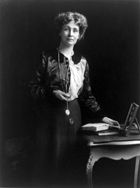Pank-A-Squith

|

|
|
|
Pank-A-Squith is named after Emmeline Pankhurst (left) and Prime Minister Herbert Asquith
|
||
Pank-A-Squith is a historical and political board game dating back to 1909, developed and published by the UK's Women's Social and Political Union for their fight for women's suffrage . The game , based on the game of goose or snakes and ladders , illustrates the struggle of the suffragettes for women's suffrage in England as well as the numerous obstacles and setbacks on the way to their goal.
background
Pank-A-Squith was made in Germany and first published in Votes for Women on October 22, 1909 . Was named the game after the suffragette and women's rights activist Emmeline Pankhurst (1858-1928) and their political opponents, the British Prime Minister Herbert Asquith (1852-1928). The game was distributed and sold through the network of Women's Social and Political Union stores.
The aim of the game is to reach the Houses of Parliament , the culmination of the campaign for women's suffrage in England. The pictures recall the dark side and setbacks of the campaign and refer to police violence against demonstrators and the force-feeding of imprisoned hunger strikers .
Equipment and style of play
| Pank-A-Squith | |
|---|---|
| Game data | |
| author | unknown |
| graphic | unknown |
| publishing company | Women's Social and Political Union |
| Publishing year | 1909 |
| Art | Board game |
| Teammates | 3 to 6 |
| Duration | about 30 minutes |
| Age | k. A. |
The Pank-A-Squith game components consist of a game board, a dice and six playing figures with sashes in the suffragette colors green, white and purple. It was sold with six painted and cast lead figures of the suffragettes and illustrated with scenes of the struggle of the women's movement. On field 6 women can be seen throwing stones through the windows of the interior ministry. At number 25, Emmeline Pankhurst was arrested on June 29, 1909 after slapping a police officer several times in the face, and at number 43 there was a woman in bed in prison who refused to eat.
It is a dice board game and is based on the goose game or snakes and ladders . It is played on a spiral-shaped game board and can be played by 2 to 6 players. At the beginning of the game, each player chooses a suffragette and places it outside of field 1. The players now roll the dice and move forward as many fields as they have thrown points. Whenever a player comes onto an action space, he must take the action specified for this space:
- Field 6 : evade the police and must return to their house on field 1.
- Space 7 : the leader brings her friends to the Clements Inn on space 17.
- Box 11 : This means delay. The "suffragette" who arrives here skips two rounds.
- Box 13 : If two suffragettes fill this box together, the inspector feels disabled and sends them both back to box 10.
- Field 14 : the suffragette here is thrown back two fields.
- Box 18 : A Bow Street judge reserves his or her decision. The "suffragette" who got off here missed a lap.
- Field 25 : the encounter with the courageous deputation means, take your luck into your own hands and throw again.
- Field 30 : Being unlucky to reach this field means going back to field 32.
- Box 32 : Even worse ! Start all over again.
- Field 33 : suspend once.
- Field 36 : suspend once.
- Field 37 : kicked out! Back to 35.
- Field 41 : Mutineers are sent to 42.
- Field 42 : here you have to miss 2 rounds.
- Field 50 : in order to achieve the goal, the exact number must be thrown; excess points are counted back.
The winner of the game is the player who first reaches the center of the field and thus the Houses of Parliament .
supporting documents
- ↑ a b c d Pank-A-Squith in the board game database BoardGameGeek (English); accessed on November 27, 2018.
- ↑ a b Pank-A-Squith, description on the website of the Museum of London ; accessed on November 27, 2018.
- ↑ Pank-A-Squith, description on the website of the Museum of Australian Democracy ; accessed on November 27, 2018.
Web links
- Pank-A-Squith in the board game database BoardGameGeek (English)